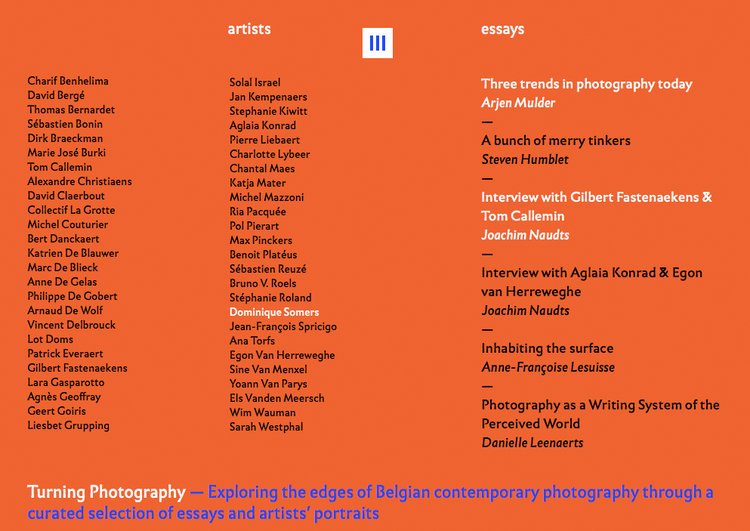Turning Photography — Exploring the edges of Belgian contemporary photography through a curated selection of essays and artists’ portraits. Kunstenpunt website, 2017. With text by Arjen Mulder.
Dirk Braeckman’s selection for the Belgian Pavilion at the 57th Venice Biennale prompted us to turn the spotlight on some of the most audacious artists working in the medium of photography in Belgium today.
Next to a broad selection of older, more established artists and photographers, Turning Photography focuses on a generation of up-and-coming young photographers and visual artists. Their work has been chosen because of its candour and lack of reverence towards more conventional photographic practices.
Turning Photography features a series of specially commissioned essays and interviews as well as a selection of portraits of artists whose work leads to an experimental exploration and critical re-evaluation of the role of the photographer in the broader field of contemporary visual art and culture.
Although photography takes on many guises in the work of both the up-and-coming and the more established photographers and artists, these practitioners have at least one thing in common: a fascination for the specific regime of visibility that has been introduced by photography. At the same time, photographers in Belgium have to engage with the same challenges that trouble photographers worldwide. Since the whole photographic system, from production and distribution to reception, has become unstable, contemporary photographers are forced into a brooding self-reflexive mood, constantly questioning the medium, asking themselves what might become of it. This has led to new and daring attempts to redefine the possibilities of the photographic system. Some artists find an answer in the digital realm; others look for renewal by reviving old analogue skills; still others attempt a radical deconstruction of the photographic process or work with the materiality and three-dimensionality of the photographic image.
Turning Photography offers an insight into the different positions of artists that exemplify today’s tendency to take the medium to the edge.



[...] What Somers has since been researching is the ontological question as to how the photographic image comes about as an object, and what that does to the portrayed and portrayer, and to our view of the world. Photography is incident light, energy that burns itself into film, fire from the sky that is tamed by the lens and allowed through in such a dose that a wonderfully clear picture of reality’s contours appears on the film. A photo is a technically controlled natural disaster.
The flashlight is indeed the photo camera’s most murderous aspect, a medial extension of the nocturnal lightning stroke. The explosion of white light, whether a bulb or powder, renders the invisible visible, but at the same time blinds what it depicts. For a moment no one no longer sees anything, neither the portrayed nor the photographer, and in that dead time, the photograph realises itself, as an acheiropoetic image, an image that is not man-made.
Acheiropoetic images in Somers’ research are, among others, the red Lichtenberg figures that appear after lightning strikes a victim’s torso and arms, as a sort of photo made by lightning with the living body as its medium. The lines form long fractal patterns, like lightning itself, or a river system, a delta, and disappear after a couple of weeks. When lightning strikes in the desert sand, it leaves fulgurites: three-dimensional glass forms in brown and ochre that are created when the sand melts during the violent discharge of energy delivered on impact. A fulgurite is an index, the image as a consequence of its content and in that sense definitive, made by the lightning strike, unique and one-off. Both are examples of what lightning finds beautiful.
In the acheiropoetic image, nature photographs itself. It etches itself into a body or condenses itself into an autonomous object. That is also what photography does. It is an acheiropoetic technique. Everything and everyone on a photograph taken with a flashlight is fulgurite. [...] - Arjen Mulder